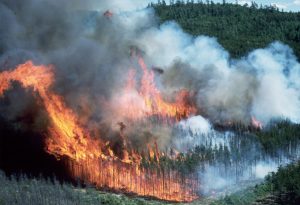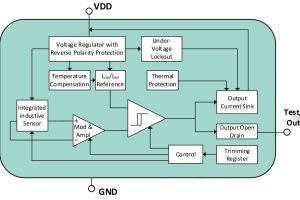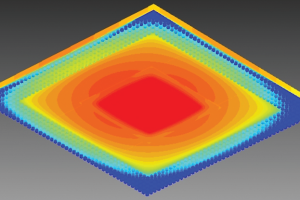Wildfires contribute approximately 20% of the world’s CO2 emissions, equivalent to the combined emissions of automobiles, airplanes, trains, and ships. Even more concerning, these wildfires trigger a chain reaction in our climate, intensifying global warming by increasing the CO2 in our atmosphere and leading to droughts and arid environments that further fuel the occurrence of wildfires.
Unfortunately, however, the existing methods of detection and mitigation are struggling to keep pace with the increasing magnitude of the issue. To combat wildfires effectively and address their detrimental effects, it is imperative that we enhance existing methods and make use of innovative IoT sensor technology, enabling early detection and swift response. This will enable us to mitigate the destructive impact of wildfires on our environment, society, and economy.
Limitations of detection
Detecting wildfires in their early stages is crucial in minimising damage and addressing the effects of these events on climate change. However, traditional wildfire monitoring systems, including satellite technology, forest cameras, and human spotters, have proven to be insufficient, with detection times sometimes exceeding several hours and rendering fires difficult to manage by the time firefighters are able to arrive on scene. This is because this technology cannot detect a wildfire until smoke is visible above the canopy.
While new technologies like AI have been introduced, the basic concept of optical detection of fires (identifying smoke plumes rising above the tree canopy) has not changed in more than a decade and the lack of innovation in advanced detection methods is drastically hindering our ability to respond quickly and effectively to wildfires.
The concept of terrestrial IoT sensors placed in the forest to detect a fire is not new – solutions have been suggested for several years and prototypes have been built, but technical and commercial challenges so far have prevented wide-scale rollout. Some solutions come at a high cost of over $1000 per sensors which, coupled with the limitations of 4G/LTE network coverage that cannot penetrate dense forest canopies, further exacerbates the challenge of scaling sensor-based solutions to large, remote areas.
Now, it is clear that a new solution is needed: a low-cost, low-power, and long-range “ultra-early” wildfire detection system that can work from within the forest and provide timely alerts regarding the precise location of a wildfire before it spirals out of control.
IoT advent
Similar to many other sectors, the forestry industry is experiencing the benefits of digitisation in its available tools and operations. Previously, this industry lagged behind due to limited network coverage in remote forest areas. However, with the advent of new IoT architectures such as LoRaWAN, network connectivity is now accessible even in the most isolated regions across the globe’s forests.
Thanks to increasingly accessible, cost-effective, and advanced sensor technology, IoT is expanding into the realm of wildfire detection. This crossover allows for the detection of wildfires within minutes.
IoT-enabled, solar-powered gas sensors, developed and manufactured in Germany, are now being rolled out across North America, Canada, Europe, and Asia to specifically mitigate wildfires and limit consequential CO2 emissions. These sensors are the first of their kind and utilise artificial intelligence to analyse the distinct “smells” present in a forest, granting them the ability to precisely detect the initial signs of smouldering fires. With the remarkable capability to detect wildfires within minutes, this system offers firefighters an unparalleled early warning.
Such timely alerts enable swift responses, enabling firefighters to tackle the fire when it is still small and easy to suppress.
To ensure these solar-powered sensors meet their energy needs when placed in shaded forest locations, a two-phase detection system is used, incorporating both air quality and gas sensing. Initial ultra-low-power air quality sensing remains active. When this detects a potential fire, it triggers the very accurate gas sensors that can analyse the smells of the forest through continuous training of machine learning algorithms. Samples of different forest types are collected and sent to a laboratory for the AI to be trained on what each forest environment smells like when burned.
Benefits of LoRaWAN
LoRaWAN, as a radio network standard, stands out as the ideal choice to provide the connectivity network for wildfire detection sensors in forest environments due to its unmatched benefits. Designed specifically for long-range, low-energy wireless communication, LoRaWAN offers unparalleled coverage and power efficiency. Its extensive reach enables sensors to transmit data over vast forest areas, ensuring comprehensive monitoring and detection capabilities.
One significant advantage of LoRaWAN is its operation in the unlicensed spectrum, eliminating the need for expensive licenses or subscription fees. This cost-effectiveness is especially valuable in remote locations where minimising operational expenses is crucial.
Additionally, LoRaWAN’s stable and mature protocols ensure reliable and long-term operation, a critical factor in the forest industry, where continuous equipment functionality is paramount.
The support for firmware over-the-air (FOTA) updates further enhances the practicality of LoRaWAN for wildfire detection. With the ability to remotely upgrade sensor devices’ software, the system becomes future-proof, allowing for efficient maintenance and the deployment of functional, stability, and security updates without physically accessing the devices. This capability is of utmost importance in large-scale deployments, such as those required in extensive forest areas, as it significantly reduces maintenance costs and streamlines system management.
The exceptional range and penetration capabilities of LoRaWAN are likewise particularly suited for forest environments. Its long-range connectivity enables effective communication even in dense forest canopies, ensuring reliable data transmission from sensors placed deep within wooded areas. This extensive coverage, coupled with the low-energy requirements of LoRaWAN, maximises the lifespan of solar-operated sensors, further reducing the need for frequent maintenance and replacement.
Considering the unique challenges posed by wildfire detection in forests, LoRaWAN’s features position it as the ultimate choice for deploying wildfire detection sensors. By harnessing the power of LoRaWAN technology, forest management and firefighting agencies can enhance their monitoring capabilities, detect wildfires in their early stages, and take prompt and effective action to mitigate the destructive impact of these blazes on the environment, wildlife, and surrounding communities.
Build a path forward
The ongoing battle against climate change is spurring the adoption and implementation of innovative IoT devices. Organisations are now envisioning novel ways to leverage technology in connecting with nature, reducing CO2 emissions, and safeguarding businesses and communities worldwide.
When it comes to wildfire management, we cannot continue the existing cycle as wildfires will just become more fierce and more frequent. Business as usual is simply not an option. In order to get a handle on wildfire management, investment in ‘ultra-early’ wildfire detection technology and LoRaWAN networks is a promising path in the right direction.
 Carsten Brinkschulte is a serial entrepreneur and visionary senior executive combining a deep technical background (with 20 years experience in mobile network infrastructure) and strategic thinking with an extensive marketing & sales track-record. He is the co-founder and CEO of Dryad Networks.
Carsten Brinkschulte is a serial entrepreneur and visionary senior executive combining a deep technical background (with 20 years experience in mobile network infrastructure) and strategic thinking with an extensive marketing & sales track-record. He is the co-founder and CEO of Dryad Networks.
Image: Canadian Forest Service (CFS)
See also: Canadian space agency signs Spire Global for WildFireSat mission
 Electronics Weekly Electronics Design & Components Tech News
Electronics Weekly Electronics Design & Components Tech News




